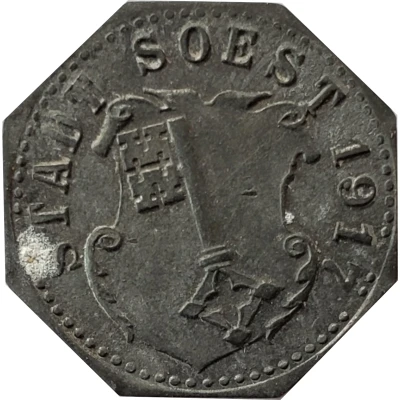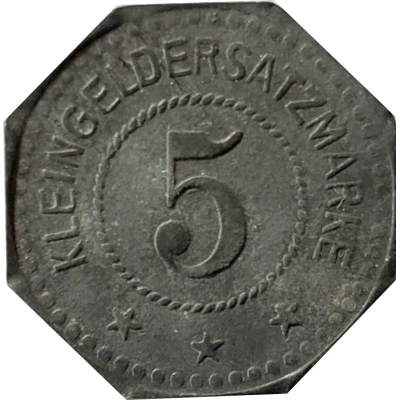


© Balestrin, Gabriel. (CC BY)
5 Pfennigs - Soest
1917 year| Zinc | 1.6 g | 19.5 mm |
| Issuer | City of Soest (notgeld) (Prussian province of Westphalia) |
|---|---|
| Emperor | William II (Wilhelm II) (1888-1918) |
| Type | Standard circulation coin |
| Year | 1917 |
| Value | 5 Pfennigs (5 Pfennige) (0.05) |
| Currency | Mark (1914-1924) |
| Composition | Zinc |
| Weight | 1.6 g |
| Diameter | 19.5 mm |
| Thickness | 1.0 mm |
| Shape | Octagonal (8-sided) |
| Technique | Milled |
| Orientation | Medal alignment ↑↑ |
| Demonetized | Yes |
| Updated | 2024-10-04 |
| Numista | N#268138 |
|---|---|
| Rarity index | 87% |
Reverse
Pearl rim, legend surrounding rope circle with denomination centered
Script: Latin
Lettering:
KLEINGELDERSATZMARKE
5
★ ★ ★
Edge
Plain
Interesting fact
The 5 Pfennigs - Soest 1917 coin from the City of Soest (notgeld) in the Prussian province of Westphalia is interesting because it was made of zinc, which was a unusual material for coins at that time. Most coins were made of metals like copper, silver, or gold, but the use of zinc in this coin reflects the economic and political circumstances of Germany during World War I, when many traditional metal resources were scarce or unavailable. The use of zinc in this coin also highlights the resourcefulness and adaptability of the people of Soest during a time of crisis.